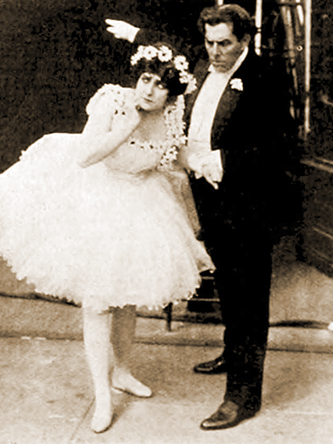| |
 |
| |
Julia Swayne Gordon and Harry T. Morey.
Photograph: Silent Era image collection.
|
The Fruits of Vengeance
(1913) United States of America
B&W : Two reels
Directed by Frederick A. Thomson
Cast: Julia Swayne Gordon [Pauline], Harry T. Morey [Pauline’s husband], Courtenay Foote [Pauline’s lover], Helene Costello [Pauline’s child]
The Vitagraph Company of America production; distributed by [?] The Vitagraph Company of America, The General Film Company, Incorporated, or V-L-S-E, Incorporated? / From a story by Marguerite Bertsch. / Released 10 October 1913. / Standard 35mm spherical 1.33:1 format.
Drama.
Synopsis: [?] [From The Moving Picture World]? The simple truth presented in this picture is that man is a combative animal and a predatory one. This is especially true where a woman is the prize covered by two males. The lady in the case is an ex-circus rider by the name of Pauline. She is married to a man of wealth, and preserves a memory of a circus performer, who in this case contributes his modest share to human evolution by walking a tightrope. This is about all that he does well, and there is nothing doing on the credit side of his ledger when he calls upon Pauline at a time when she begins to long for a little variety in life, such as is afforded by automobile tastes with a trolley-car income, the lot of the average circus performer. The husband does not approve of the invader, and instead of carrying his wife away to Palm Beach for a season he bursts into all kinds of rage; there are fifty-seven varieties shown in this screen portrayal, and so outrages his wife’s self-respect that she leaves him and goes back to the old life, taking her little girl along. On account of this act of folly on her part, her husband decides to devote the remainder of his existence to the business of retaliation. With the privileges his wealth and leisure afford for doing something worthwhile, he devotes his career to gratifying a bitter desire, sure indication of a perverted or decadent mind. He goes forth completely disguised and reappears as the proprietor of a circus in order to effect a dramatic vengeance and he thus becomes the employer of his wife and her lover. He is not particularly subtle, else he could have driven them gradually into acute poverty, the worst punishment doled out to human beings of health and ambition. He bides his time until the rope walker is dazzling an audience. (The audience is made up of exhibitors who visited the Vitagraph yard during the convention.) The dirty work, that of cutting the rope, is discovered and some athletes climb up rope ladders to the swings to save the little girl on the ropewalker’s shoulders, the daughter of the man who planned the dastardly deed. The husband now realizes that his scheme may react and attempts to climb after the athletes, but his time has come. The men on the swings save the child through their daring and skill. For some reason or other they also save the family breaker as well. The husband, who felt himself to be a wronged man because of the loss of his wife and child, who attempted to destroy the enemy of his peace and happiness, falls to his death.
Survival status: (unknown)
Current rights holder: Public domain [USA].
Listing updated: 12 November 2022.
References: Pohle-Holmes p. ? : Website-IMDb.
|




































